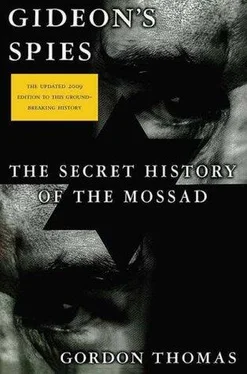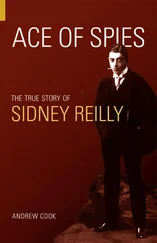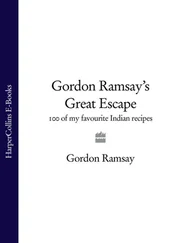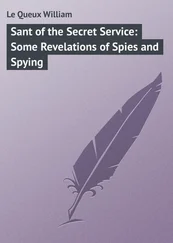Gordon Thomas - Gideon's Spies
Здесь есть возможность читать онлайн «Gordon Thomas - Gideon's Spies» весь текст электронной книги совершенно бесплатно (целиком полную версию без сокращений). В некоторых случаях можно слушать аудио, скачать через торрент в формате fb2 и присутствует краткое содержание. Город: New York, Год выпуска: 2009, ISBN: 2009, Издательство: Thomas Dunne Books, Жанр: История, на английском языке. Описание произведения, (предисловие) а так же отзывы посетителей доступны на портале библиотеки ЛибКат.
- Название:Gideon's Spies
- Автор:
- Издательство:Thomas Dunne Books
- Жанр:
- Год:2009
- Город:New York
- ISBN:978-0-312-53901-6
- Рейтинг книги:4 / 5. Голосов: 1
-
Избранное:Добавить в избранное
- Отзывы:
-
Ваша оценка:
- 80
- 1
- 2
- 3
- 4
- 5
Gideon's Spies: краткое содержание, описание и аннотация
Предлагаем к чтению аннотацию, описание, краткое содержание или предисловие (зависит от того, что написал сам автор книги «Gideon's Spies»). Если вы не нашли необходимую информацию о книге — напишите в комментариях, мы постараемся отыскать её.
Gideon’s Spies
Gideon's Spies — читать онлайн бесплатно полную книгу (весь текст) целиком
Ниже представлен текст книги, разбитый по страницам. Система сохранения места последней прочитанной страницы, позволяет с удобством читать онлайн бесплатно книгу «Gideon's Spies», без необходимости каждый раз заново искать на чём Вы остановились. Поставьте закладку, и сможете в любой момент перейти на страницу, на которой закончили чтение.
Интервал:
Закладка:
This was a land where Alexander the Great had lost an entire division one winter and, centuries later, where the Russians had fought, and lost, their war against the Mujahideen tribesmen of Afghanistan. And here, against a mountain peak cloaked permanently in snow and deep fissures splitting the rocks, American Special Forces had lost some of their finest in their search for Osama bin Laden.
The most advanced technology in the world had been mobilized in that hunt. A hyperspectral satellite, the first of its kind, was geopositioned in the deep black of space, its hundreds of narrow wavelength bands designed to reflect energy from objects on the ground to detect specific terrain such as rock, vegetation, buildings, caves, and any human presence. Another satellite used the “spectral fingerprints” to take mono photos, each with a resolution of ten centimeters per pixel. Synthetic Aperture Radar (SAR) transmitted images at night in the often atrocious weather conditions of the area. Drones—unmanned aircraft—had constantly imaged an area the size of California every twenty-four hours from a cruising height of sixty-five thousand feet. Closer to ground, Predators—other radio-controlled unmanned aircraft—flying at heights of one hundred to twenty-five thousand feet had relayed data to where the Special Forces waited beside their helicopters, each fitted with “whispering technology,” which made their approach virtually silent. They were armed with AGM-130 missiles that could be radar directed into the mouths of tunnels where bin Laden could be hiding. But the targets had been few and far between, and none of them had been the serpent’s den of the most wanted man in the world.
Now in the spring of 2005, America’s wonder weapons had gone to search elsewhere. Their departure had brought a wry smile from Meir Dagan when he had observed that technology still could not outsmart human intelligence. There is a saying in Mossad that information was only as good as its source. Jamal believed in Horaj he had the best. Jamal was not only fluent in Pakistan’s official language, Urdu, but in several of the local dialects. But like all else about the two men, the dialect they conversed in was cloaked in the essential secrecy upon which their lives depended. Horaj’s ethnic group—whether he was a Punjabi, a Sindhi, a Pushtu, a Baluchi, or a Muhajir—was known only to Jamal and his case officer in the Directorate of Operations. All other personal details, such as his age and marital status, were similarly restricted. Most protected of all was where Horaj worked and the level of access he had to information valuable to Israel. Consequently, none of his reports ever ended up in the Mossad archive’s file on the individual whose actions had once more brought the two men to their clandestine meeting.
The man was Pakistan’s leading nuclear scientist, Abdul Qadeer Khan. Physically unremarkable, his lack of size was compensated with a winning smile for any woman who caught his eye—and many did—and matched by an overbearing arrogance toward those who dared to challenge him. He had easy access to Pakistan’s leaders; lesser politicians spoke his name with awe. Those who refused to do his bidding found themselves banned from his inner circle; former prime minister Benazir Bhutto admitted that during her term of office even she was not allowed to visit Khan’s research laboratories. It was there, in July 1976, he had used his years of research in Germany, Belgium, and Holland to understand the techniques for producing the enriched uranium needed to make a nuclear bomb. Eight years before, after neighboring India had tested its own nuclear bomb, Khan had been put in charge of Pakistan’s nuclear program.
Mossad discovered that during his time in Holland on the staff of the Physical Dynamics Research Laboratory (FDO), Khan had access to the nearby URENCO uranium enrichment plant at Almemo. Established in 1970 by Britain, West Germany, and Holland, it provided a supply of enriched uranium for European nuclear reactors. To do so it used highly classified centrifuge technology to separate fissionable uranium-235 from U-238, spinning a mixture of the two isotopes at up to one hundred thousand revolutions a minute. Mossad established that successfully mastering the complexity of this technology had enabled Khan to create Pakistan’s own nuclear arsenal in the utmost secrecy. After doing so, the country’s newspapers front-paged his boast: “Our detractors who told the U.S. that Pakistan could never produce the bomb now know we have done it.” For adoring millions of Pakistanis he became a revered figure, the genius who had provided a means to stop any preemptive strike by India.
Khan had remained a magical figure like no other in Pakistan, perhaps like no person in the Muslim world they had read about in their newspapers or heard of on radio or television. Fawned upon by the rich and famous, he was invited to sail on their luxury yachts on the French Riviera, flying there in their private jets.
Mossad knew there was another darker, and for Israel, far more dangerous side to Abdul Qadeer Khan. During one of his European jaunts, a Mossad agent had managed to gain entry to Khan’s hotel suite and accessed his briefcase. Using a matchbox-sized camera, the agent had photographed documents that provided the first concrete evidence that Khan had recently bought five thousand specialized magnets from a government company in Beijing. The magnets were to speed up the process of uranium enrichment. Other documents showed that Khan had also made contact with other aspirant nuclear states, notably North Korea, Iraq, and Iran. In his book-lined office was a report from the John F. Kennedy School of Government at Harvard University. Khan liked to show visitors the passage he had highlighted: “A 10-kiloton bomb is smuggled into Manhattan and explodes at Grand Central. Some half-a-million people are killed and the United States suffers $1 trillion in direct economic damage.” Khan would snap shut the book and replace it without comment on its shelf, no doubt secure in the knowledge he had created for Pakistan the weapon to achieve such a horrific scenario. Khan was the flawed genius, not only motivated by personal greed but also driven by a religious fanaticism and a contempt for Western values. As the Khan Research Laboratories became a mecca to which the scientists of third world nations came to seek his services for helping them acquire skills in the black art of nuclear bomb making, he had become rich and powerful. He had also become a target for Mossad’s kidon. The unit had begun the slow, meticulous process of ascertaining all information its assassins needed when devising the most effective way of killing him.
Mossad had already dealt with one foreign scientist who had been identified as a threat, Gerald Bull. He had created, for Saddam Hussein, a supergun capable of launching nuclear warheads directly from Iraq into Israel. On March 20, 1990, three kidon had executed Bull on the doorstep of his luxury apartment in Brussels (see chapter 6, “Avengers,” pp. 119–21). However, assassinating Khan was more complex. He was a national hero and the repercussions would extend beyond any direct retaliation against Israel. While Washington had imposed sanctions on both Pakistan and India for conducting nuclear tests, the United States wanted to maintain its support against the steady expansion of China; it would condemn Israel for the assassination. Nevertheless, kidon were asked to prepare a number of “options”—the detailed research that would be the prelude to any killing of Khan. Ari Ben-Menashe, who had tasked kidon to prepare “options” during his time with Mossad, said (to the author): “What they were doing was essential to their kind of operation. Their baseline is getting to know their target, his or her habits and style. How he or she reacts to a situation, what pushes his or her buttons. Only then could they construct an operational plan.”
Читать дальшеИнтервал:
Закладка:
Похожие книги на «Gideon's Spies»
Представляем Вашему вниманию похожие книги на «Gideon's Spies» списком для выбора. Мы отобрали схожую по названию и смыслу литературу в надежде предоставить читателям больше вариантов отыскать новые, интересные, ещё непрочитанные произведения.
Обсуждение, отзывы о книге «Gideon's Spies» и просто собственные мнения читателей. Оставьте ваши комментарии, напишите, что Вы думаете о произведении, его смысле или главных героях. Укажите что конкретно понравилось, а что нет, и почему Вы так считаете.












